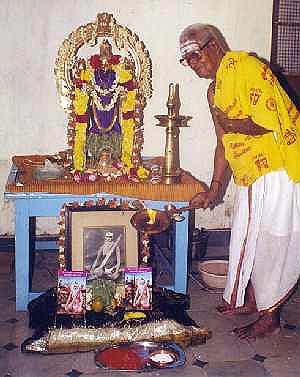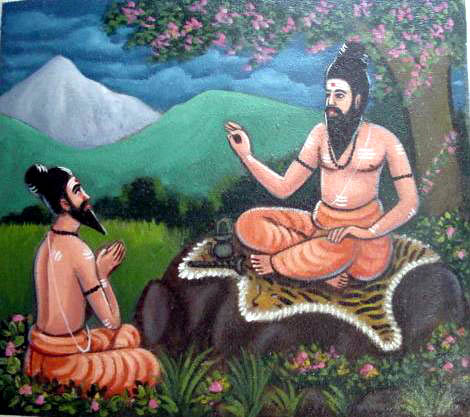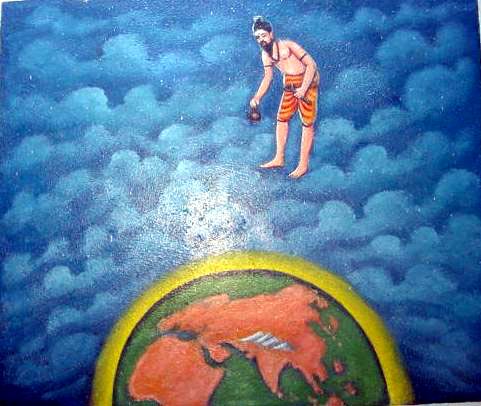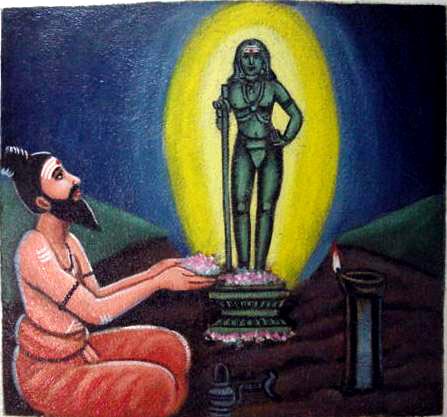
Thursday, February 25, 2010
Tuesday, February 23, 2010
Sunday, February 14, 2010
Rathinagiri Bala Murugan Adimai
Rathinagiri Bala Murugan Adimai
| One day in his 27th year, a young man on his way to work as a clerk in the Electricity Department climbed the Rathinagiri Hill to offer his prayers. There was neither camphor nor incense available at the poor and delapitated temple. He walked around the shrine with a heavy heart and was suddenly overcome with divine awakening. He fell in a faint to the ground and on waking up was unable to remember his own self. He dressed himself in a loincloth. He took a sacred vow not to leave until the temple was restored to its former glory. This memorable event of Swami's spiritual awakening took place on 20th March 1968. Ever since then Swami's spiritual well being of his devotees has continued unabated. Swami maintains maunam all these years, but he agreed to give this written account on 27 October 2001. |
"(Until that fateful day) I was not so fond of bhakti, but I used to pass by this way every day to reach my office work by 9 am. While passing by I would offer worship just like other people.
But on that 20th March 1968 I climbed the hill to have darshan. I asked the priest who was doing puja to burn a little camphor for aradhana. He said, "We have no camphor and no incense."
I felt like crying. I came out from the moolasthanam and went for pradakshinai (circumambulation) and worship seeing the Deity.
At that moment I lost all my other concerns and made up my mind to have a vow to make the poor sanctum of Rathinagiri to be as glorious as the Lord's Aru Padai Veedukal.
Then from my heart the inner feelings rose up addressing Lord Muruga, saying, "Oh, what a Deity you are! I heard that you have six Padai Veedukal where you enjoy pujas six times daily. All the devotees visit you there full of confidence in you. At those places you are as a Deity. Here also you are a deity, but what a pitiable situation for you here."
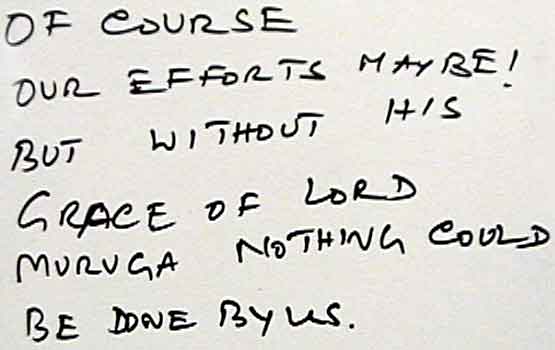 |
From that day onwards I have been observing maunam (silence) and doing my prayers. Now when visitors come to the temple, I am offering them food and hospitality. Now you can see the change in status of the temple. It is not I but the Lord or His Grace (that makes this possible). Sample of Rathinagiri Bala Murugan Adimai's handwritingSample of Rathinagiri Bala Murugan Adimai's handwriting
The Picture Below Is A CLEAR Sample Of RATNAGIRI BALA MURUGAN ADIMAI'S HANDWRITING
Sri Santananda Swamigal
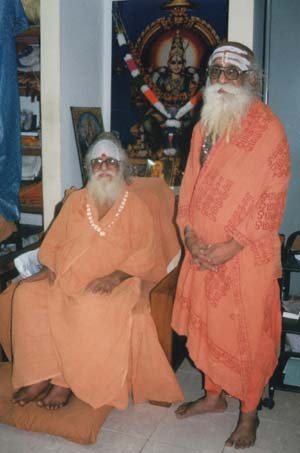
God manifests himself once in many centuries to protect the righteous, to destroy the wicked and to establish dharma firmly. In between, very often. He causes the birth of noble souls to propagate righteousness. These are the saints; the saviors of society; the salt of the earth.
Most of these messengers of God did not have a safe passage while alive. They were pilloried and persecuted; They were crucified or hanged. Their sufferings purified our souls. But God never let down his devotees. At the eleventh hour, he always came to their rescue.
The uniqueness of Indian tradition is that one can consider even another human being as god. Therefore many a spiritual aspirant in our country worshipped their guru as god. That is why the tradition of a guru never goes dry in India. It is kept alive and carried on from generation to generation by worthy disciples. No wonder that while Judge Swamiji established the Avadhuta tradition in Tamil Nadu and while Swayamprakasa Swamiji saw to it that it took roots, Santananda Swamiji has devoted his time and energies to nurturing it.
Madurai has been, down to modern times, a most prominent centre of spirituality in Tamil Nadu. It is the abode of goddess Meenakshi. The hoary temple of Meenakshi is intimately associated with many saints and seers of Tamil Nadu. The great sage Ramana Maharshi used to go there everyday and "experience an exaltation every time he stood before the images of the gods and the saints". Swami Santananda also is associated with this holy city. This place is associated with the divine wedding of Lord Siva.
In a small village near Madurai there lived an orthodox Brahmin family. The couple were great devotees of Meenakshi. They had nine children. A famous ascetic of the time. Mayandi Yogi, visited them one day. He predicted that they would have one more child, their tenth. "A son would be born. He would be a votary of the Vedas, a supporter of yagnas, a repository of knowledge, an ideal disciple, a man of action for the welfare of the world and a devotee of goddess Bhuvaneswari. Call him Subrahmanya. He will be yours only during his formative years. Then the world gets the monopoly over him. Like Adi Sankara who left his house and village when he was barely eight, your would-be son also would leave you behind. As you would be instrumental in causing his birth, you would get salvation automatically. Therefore from now onward you should cultivate detachment towards your would-be son so that you would not obstruct him when the time came for him to renounce worldly life".
Mayandi Yogi had the gift for looking into the seeds of time and saying which grain will grow and which will not. Hit prophecy was fulfilled. Sixty years ago a son was born to the pious couple. They called him Subrahmanayam. It was an apt name. Lord Subrahmanya dares to teach even Lord Siva, his father. He is the God of spiritual knowledge, the deity of yagnas and the supreme commander of the divine army. He appears in the form of iridescent flame. He blesses His devotees with youth, beauty and knowledge.
At the appropriate age the boy was admitted in a school. He had phenomenal memory. Whatever he learnt at school he was able to retain it. Whenever he had leisure he spent his time in the Meenakshi Temple. One can say that he had learnt everything in his previous birth his message-not to learn, but to teach; not to be ministered unto, but to minister.
Mayandi Yogi made another visit to the boy's house. He was thrilled to see the boy. He suggested that the boy be admitted in a Sanskrit school to learn the Vedas and be sent to him after his studies were over. Accordingly the boy was admitted in the Naganatapuram Veda Patasala, Karaikudi. In course of time, Subrahmanyam became well versed in the Vedas.
It was the time of our freedom struggle. Gandhiji had appeared on the scene. Everybody came under his spell. Subrahmanyam's idealism responded to the call of the Mahatma. He plunged into constructive activities. Gandhiji had drawn up an 18-point work list which was countryside prosperous and happy. Subrahmanyam also concentrated his activities on village uplift and amelioration of the lot of the poor.
And he got the reward of imprisonment, the only reward patriots all over the world get. By a strange coincidence he was sent to Alipur Prison. This prison had played a special role in the case of Aurobindo. It is here that the revolutionary was transformed into a mystic. In the prison he saw in a vision the spirit of God all around him in the prison compound and, later, again in the court and heard a definite message.
![Santananda Swamigal at the feet of Sri Bhuvaneswari [21k]](http://murugan.org/pix/santa_03.jpg) |
| |
Stone walls do not prison make
Nor iron bars a cage;
Minds innocent and quiet take
That for a hermitage.
Prison became a hall of meditation for Lokamanya Tilak, Mahatma Gandhi and our Subrahmanyam. Here he studied the writings of Swami Vivekananda deeply. When he came out of the prison, he was no longer the same. This devotee of the Mother country became the devotee of the Mother Goddess. From Alipur he went direct to Madurai. He prayed to Goddess Meenakshi to show him the further course of action.
Then he approached Mayandi Yogi, who was extremely happy that notwithstanding an eventful life, Subrahmanyam did not fail to turn up when the hour arrived. He taught the youth the art of meditation and explained the monosyllabic mantra of Goddess Bhuvaneswari. He asked him to chant it unceasingly so that he could have mastery over the sense. He further advised him to remain silent and to subsist on alms and also not to stay at a place for long.
Brahmachari Subrahmanyam began his wanderings. He visited many places -- Agastya Hill, Courtalam, Tiruchendur, Tirupati, Tirunelveli, Palani, to name a few -- and did penance there. Sometimes he was mistaken for a child lifter and beaten or handed over to the police. As he kept the vow of silence, he was kept in custody for some days before he was found innocent and released.
Subrahmaniyam traveled everywhere on foot and survived on alms. He did penance at many sacred places. Then he commenced his pilgrimage to North India. He visited Badrinath, Kedarnath, Nepal and Rishikish. He stayed for some time in Rishikesh and served Swami Sivananda.
Here was an ideal disciple whom many preceptors longed to adopt. But Subrahmanyam was searching for some other type of Guru. He searched everywhere -- in forests and mountains, on river banks and in temples.
Once in the Nellaiappar Temple, Tirunelveli, When he went on dashing his head against the floor, as a part of his penance, he had the vision of an avadhuta commanding him to follow. As soon as he got up, the vision disappeared. But he often heard the echo of the command. He was Searching for only that particular avadhuta so as to become his disciple.
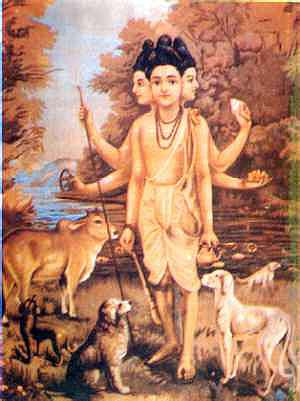 |
| |
On the Girnar Hill, Gujarat, there is a holy place known as Sri Datta Paduka Peetham. It is a favorite haunt of ascetics. Tradition is that only after initiation, avadhutas used to visit here. Subrahmanyam reached there even before his initiation.
It is an arduous task to climb the hill and reach its top. The place was surrounded by dense forests and was the habitat of wild animals. One had to climb hundreds of steps to reach the top. Subrahmanyam was indisposed and weak.
An unknown sadhu appeared and said. Why do you hesitate? Datta Guru is always with you. You swallow this pill and ascend the hill'. He vanished. Who was he, whence he came, and why? Nobody knew.
Subrahmanyam swallowed the pill. He felt rejuvenated and light. His mind became alert and his body strong. He climbed the hill and had the darshan of Datta paduka. He heard a voice commanding him to go to Sendamangalam (Salem district) where a Guru was waiting.
One day he reached Sendamangalam and had the darshan of Swami Swayamprakasaji. At once he realized that the avadhuta he saw in a vision at Tirunelveli was none other that Swamiji and requested that he be accepted as a disciple.
![Sri Sadguru Swayamprakasa Brahmendra Saraswatyavadhuta Swamigal [15k]](http://murugan.org/pix/swayamprakasha.jpg) |
| |
Swamiji gave his consent. He admitted Subrahmanyam into the Avadhuta order and gave him a new name-- Santananda. Avadhutas were not expected to wear clothes. But the ignorant people do not understand the significance of nirvana. Therefore an exception was made in the case of Santanandaji and he was permitted to wear an ochre robe.
Next Swamiji explained the mission of Santanandaji. He told his disciple: "You have learnt the Vedas. You excel in the art of meditation. You have traveled widely and are experienced. I wish to engage you in a special work. You take charge of the Pudukkottai Adhishtanam of Judge Swamiji, my Guru. Maintain it and make it a place for pilgrimage. For one year practice the vow of silence. Subsist on alms. Stay under trees. Don't ask for anything from anyone. Ask only the spirit of Judge Swamiji to fulfill your needs. You will succeed."
 |
| |
 |
Santanandaji arrived at Pudukkottai. The Adhishtanam was in the midst of a grove of neem trees. There was a small tower above the tomb. Santanandaji scrupulously followed his Guru's command. He did not talk to anybody. He stayed near the Adhishtanam day and night. Whenever hungry, he simply ate the neem leaves. In sun and rain he took shelter under a tree.
Devotes started to trickle in. They were impressed by the austerity of the young Swami. They not only gave him food but also built a small room close to the Adhishtanam.
A year was over. The vow of silence too was fulfilled. Swamiji explained to the devotees the reason for his arrival and stay. Advocate Sri. P. Balasubrahmanya Sastri, the owner of the land, made deed of gift and relinquished his right over the land where the crypt existed. Then Swamiji arranged for a huge painting of Bhuvaneswari and continued his meditation in its presence.
Next, the idols of Ganapati and Karttikeya were installed on either side of Adhishtanam. Swamyamprakasa Swamiji had earlier installed a linga and an image of Santanandaji took care of his Adhishtanam also in Sendamangalam. He got the cave where his Guru lived repaired. He even went abroad to collect donations for expanding the Adhishtanam.
The most important step he took was the installation of the idol of Bhuvaneswari. None can describe the transcendental beauty of this idol. Two of Her hands carry the noose and hook and another two assure protection and give boon respectively. The divine face glows with angelic beauty and the eyes are full of compassion. The smile comforts the afflicted. She is the substance of the Gayatri mantra and the Parasakti of the Kenopanished.
Buildings grew. Devotees thronged to the Adhistanam. Houses were built. The lonely area came to be called Sri Bhuvaneswari Nagar. In the Adhishtanam, pujas are not performed for the sake of or on behalf of individuals, but for the welfare of the world.
After the installation of the idol of the Goddess, Swamiji started a new programme of performing yagnas each year. Hundreds of devotees from far and near witness them. Swamiji has unshakable faith in yagnas. He believes that they will make India powerful and prosperous. The angels become happy whenever a yagna is performed. In the Vedas we read: Sacrifice (Yagna) is the foremost of our duties. It is the mainstay of the world. It bestows blessings on all things. It is the boat to cross the ocean and live well. Only through it the Gods attained the heaven. Through it deliverance is afforded.
In the Gita (3:10) we find the following idea: In the beginning, while creating the human beings, God instituted the sacrifice and said, "May this grant your desire like Kamadhenu and may you grow with its help."
The angels accept only the food offered in a sacrifice. When they are satisfied they send rain. As a result there will be no scarcity of water and people reap a rich harvest. This process has been mentioned in the Gita (3:14). Lord Krishna declares that I am Yagna (Gita 14:16) Scoffers of Yagnas should ponder over these ideas. Elders believe that Pudukkottai, which was an arid zone two decades ago, has become fertile because of heavy rains coaxed by these Yagnas. During the Yagnas reputed scholars of the Vedas and eminent musicians arrive at Pudukkottai and are honored and blessed by Swamiji. Every year coinciding with the Yagna, Swamiji releases a new book. In this way many spiritual works have been published for the upliftment of the people.
Once Swamiji had an enchanting vision. He saw hills all around. A streamlet was flowing below. From the hills on e could see villages and green fields. Lord Skanda told Swamiji that it was there that He would like to reside.
Swamiji used to narrate this vision to devotees. One day in 1966 a devotee presented an idol of Dandayudhapani to Swamiji. But did really such a spot exist as seen in the vision?
![Skandasramam today [13k]](http://murugan.org/pix/skandasramam_1.jpg) |
| |
In 1967 a devotee informed Swamiji that there did exist such a spot. With him Swamiji visited Udayapatti village which is five miles from Salem on the Athur Road. He could not believe his eyes. To the minutest detail his dream was found transformed into reality there.
The site belonged to the government which is supposed to be secular. People feared that the government would not sell the land for building a temple. Even if it agreed, it would take a long time on account of red tape to get its consent and would involve a mass of correspondence shutting between the parties. However, a petition was sent.
Miracles do happen even now. In a week the government issued orders handing over the land to Swamiji. That year he arranged for lighting Skanda Jyoti. The hill near Udayapatti got the name of Skandagiri. It is surrounded by three hills giving the impression that Sri Dandapani is surrounded by Trimurtis. Coconut trees, green valleys and flowerbeds add to the scenic beauty of the place. The atmosphere is peaceful and is conductive to penance and meditation. A rivulet known as Kannimar Odai flows at the foot of the hill. There is a temple of Kanya Devi on its bank. She blesses women devotees with good husbands and conjugal happiness.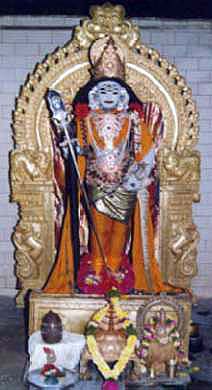
Swamiji built a beautiful temple on the hill dedicated to Lord Dandapani and Goddess Durga. A big hall for discourses and a guest house also were built. On the southern and northern sides there are temples for Vinayaka and Hidimba respectively. The main temple has a large number of idols of Vyasa, Sankara; Madhva, Ramanuja, the four great 'Nayanmars' (Saivite saints), etc. Many more idols of religious leaders are going to be added, testifying to Swamiji's synthetic approach to religion.
It is Swamiji's belief that if the Vedas are protected the world will prosper. Therefore he is conducting Yajurveda Patasalas in Pudukkottai and Skandagiri. Here students get free boarding and lodging facilities. After Swamiji, who? Swamiji is never worried about the future. He has established two trusts, one for Pudukkottai Adhishtanam and another for Skandasramam. These trusts maintain accounts meticulously and up-to date. For the dissemination of spiritual ideas and to encourage scholars of Hinduism to express their ideas, Swamiji is conducting a Tamil monthly, "Sri Bhuvaneswari Vijayam".
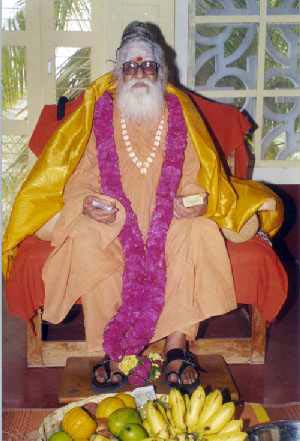
A glimpse of the Swamiji is enough to convince anyone of the beautiful harmony of the physical and spiritual powers both found in perfection in him. Long red, matted locks; broad forehead adorned with sacred ash and kumkum; a face glowing with peace as a result of emotional asceticism; eyes shining with a rare brightness and compassion- no wonder that our forefathers attached great importance to the darshan of saints. He performed arduous penance for many years. And yet, or perhaps as a result, his body gleams like gold. He looks neat, very clean and almost dapper. He bears himself with naturalness and at the same time with dignity. He has sweet words for everybody. His voice is like music, bringing solace to the afflicted. Pilgrims from far and near come to him for instruction, advice and consolation.
Swamiji is a scholar in Tamil and Sanskrit and a great lover of music. Wherever he goes scholars and musicians gather round him to have their doubts clarified and to be inspired by him. Propagation of the Vedic knowledge and encouragement to scholars are the twin aims that lie closest to his heart.
Swamiji spends much of his time in meditation and in chanting the holy names or mantras of Sri Bhuvaneswari and Sri Skandaguru. His meditation has no tinge of selfishness. It is not for nothing that his favorite deity is Sri Bhuvaneswari- the presiding deity of the universe. He prays for the welfare of all sentient beings- 'man and bird and beast'- and he loves 'all things both great and small'. For the dear God who loveth us He made and loveth all.
Sri Kripananda Variar Swamigal
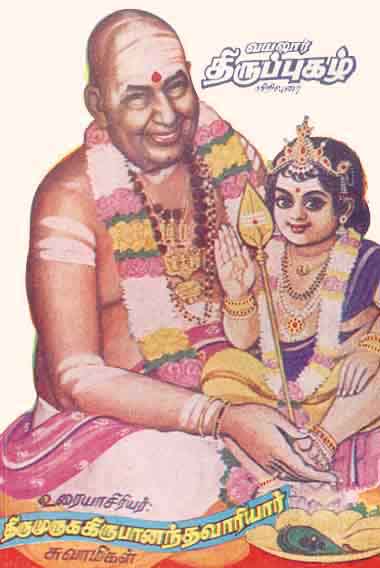 |
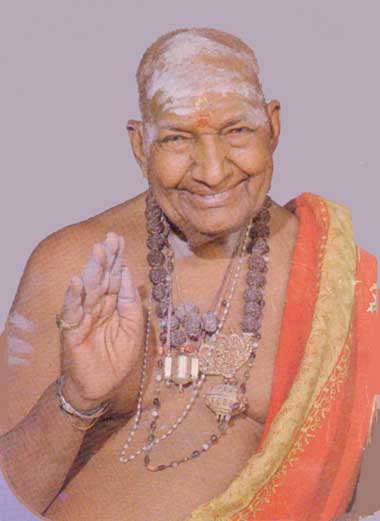 |
| Srī Kripānanda Vāriār Swāmigal |
If the tidal waves of atheistic propaganda which swept the shores of Tamilian traditions and tried to erode the minds of the public a decade ago can now be said to have been halted, the success must be attributed to our religious leaders, scholars and exponents of classics. What could not be achieved through institutional efforts was accomplished by individual endeavours. Among the large band of front-ranking evangelists who still continue this crusade against ignorance and irreligions, is Sri Kripananda Variar.
This 59-year old Tamil pandit and ardent devotee of Lord Muruga, spends daily on an average three hours in expounding the great epics before mammoth gatherings, travels more than 200 miles to meet and discuss with people, runs one of the best magazines exclusively devoted to religious subjects (ti has just completed 30 years of uninterrupted existence), replies to hundreds of queries about matters pertaining to religion and allied topics and conducts research into various aspects of theology -- all these in addition to the minimum of two hours he spends in puja to Lord Subrahmanya.
In his musical discourses he brings out intricate philosophical truths in a lucid and racy style, illustrating it with parables, short stories and personal anecdotes. Interspersing his homilies wiht copious humour, he covers a wide range of topics touching on current politics as well, and making subtle digs at those who deride all that they consider odl and ancient. Ramayanam, Mahabharatam and Skandam are his fortes, though he lectures on several other works with equal eloquence.
Hailing from Kangeyanallur near Vellore from a family of Tamil scholars, Sri Kripānanda Vāri is one of eleven children of Mallayyadas Bhagavatar. Helearnt the rudiments of Tamil history under his father, showing evidence of precocity by composing poems at the age of five and giving a discourse before an audience at the age of nine. He had no formal schooling. Today he is held in deep respect by men of letters, who consider him an authority in Saivite literature.
Even while young, Sri Kripānanda Vāri embarked on a programme of service to humanity by giving discourses. Married at 19, he moved to Madras, where he continued his study, lectured to enlightened audiences and learnt veena under Thenmadam Varadachari. Later he received initiation at the hands of the great savant Sri Eesana Sivacharya and mastered Tiruppugazh through Madurai Tiruppugazh Sami Aiyar. He also made a deep study of Tirukkural, Tēvāram and other classics.
Sri Kripānanda Vāri's sole aim is to preach religion and utilise his talent and resources to help poor students, educational institutions and temples. The temple at his birthplace is today a showpiece of art. He took a leading role in several religious works such as construction of towers at Vayalur and Kosapet (Madras) and reconstructing the temple at Mohanur. He has also helped in the collections of funds for the renovation of the Madhavaperumal Temple in Mylapore, the Sri Balasubramania Swami Temple (Teynampet) and the Muruga Temple in Valli Malai. Among his recent projects of reconstruction are the Kosapet temple tank and the Samayapuram Mariamman Temple.
It was at Vadalur, the headquarters of Jothi Ramalingaswami, that Sri Kripānanda Vāri founded the journal Tiruppugazhamirtham. In its inaugural number he dedicated an elaboration of the verse Kaithala niraikani which he still uses as invocation at discourses. He rebuilt the Sathya Gnana Sabha at Vadalur and completed the task of founding a seat of learning there by 1950, collecting rupees four lakhs for the purpose.
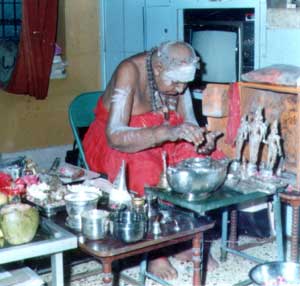 |
| Kripānanda Vāriār performing daily puja |
At a time when literary discourses in Tamil were looked down upon, Sri Kripānanda Vāri gave a new orientation to them and demonstrated that bhakti was the tap root of Tamilian traditions. Soft spoken and humble, he is ever a student.
The latest among his several commentaries is on Kamba Rāmāyanam and it is to be followed by an analysis of Villiputhurar Bhāratham. He has been the recipient of titles from Sri Sankaracharya of Kanchi, the Jeer of Ahobila Mutt, the Dharmapuram and Madurai Adheenams and Swami Sivananda of Rishkesh.
Sri Kripānanda Vāri has toured Malaya and Ceylon [Note: and many, many other countries since this article was published in 1966], serving as our cultural ambassador.
Vallimalai Satchidananda Swamigal
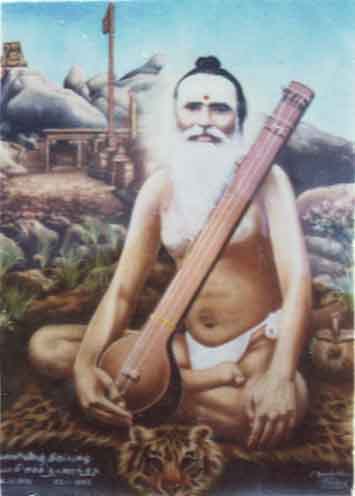 |
| Vallimalai Satchinanda Swamigal |
There have been many narrations in print by various devotees, particularly, Sri R. Kalyanasundaram (1957) and Swami Anvananda (1975) but few copies remain as they are long out of print. However it is my attempt to present information received directly from Swami as well some of the earliest episodes prior to 1948 narrated to me during the period of my contact with him.
Under a divine order alone my first contact with the great soul Sri Sacchidananda Swami occured at his beloveed Tiruttani on 31 December 1948 during the Step Festival initiated by Swami in the year 1917-18 (as I learned later from Swami in detail). Prior to that first encounter I had had a dream of Sri Ramana Mahārshi of Tiruvannamalai leading me up a ladder, standing in an empty field. In the middle he disappeared and in his place a stalwart figure was leading me further up.
I later recognised the stalwart figure as Sri Vallimalai Swami as introduced by my friends who accompanied me enroute to Tiruvannamalai for darshan of Sri Ramana. The dream and its symbolism became a key factor in my life. I had the great fortune to move closely with Swami for about two years from 1948 to 1950 when he attained samadhi at the ripe age of 80.
At that time Swami needed help owing to old age. During his permanent stay at Chennai until 1950, my services were readily accepted by Swami and thereafter hardly a day passed without my meeting him till the end. During this period he helped me in various ways to practise spiritual sadhana.
 |
| Saint Arunagirinathar at Tiruvannamalai |
At Palani, Swami was ordered by Lord Murukan to go to Tiruvannamalai, the birth place of Saint Arunagirinathar, where he could come in contact with the great saint Sri Ramana Bhagawan. In Sri Ramana, Swami saw the avatar of Sri Palani Āntavar (Lord Dandapani). Swami could learn properly the meaning and candam (cadence) of Tiruppukal. By the grace of Bhagawan, he mastered everything and rendered the songs in an emotional manner.
However, by the order of Sri Ramana Bhagwan, the search for a guru by Swami ended in meeting Sri Sēśādri Swamigal at Tiruvannamalai, who has also confirmed that Tiruppukal songs are mahā mantrams, by reciting which all could be achieved. A parallel śloka from Śiva Manasīkapūja by Adi Śankara (4th śloka) was equalised by Swami by rendering a Tiruppukal song (Ācaikkor paktan).
 |
| Vallimalai Satchidananda Swamigal |
Thenceforth Sri Seśadri Swamigal directed Swami to go to Vallimalai, the famous abode of Lord Murukan and His Consort Sri Valli, as explained in Kantap Purānam. Swami stayed at this place more than 38 years for his spiritual sādhana as well as to bless devotees irrespective of cast or creed, young or old, rich or poor. Ultimately Swami had a rare experience at Vallimalai culminating in darśan of Lord Murukan and Sri Valli.
His attachment towards Devi Sri Valli was very great. He used to tell me often that we should always praise Sri Valli through Tiruppukal songs, so that She will point out to Lord Murukan at an opportune moment all our our needs, which He will fulfil readily as the request comes from his Consort.
Swami used to find the grace of Sri Valli in all and believed that Lord Murukan alone was Purusha and all the jīvas were only His consorts. (Jīva-BrahmĀ ikyam). In this connection Swami had complied with the help of Tiruppukal songs a medical with very great spiritual significance to the theme "Tiruppukal Jñana Saccidānanda Valli Caitam" (more details later).
At Vallimalai he was a true illustrator of ideal bhakti. He never suffered for want of money or means of sustenance. But he always spent away then and there whatever money came to him and never retained a pie for morrow. He was very particular to feed the needy and believed that service to fellow beings was only true service.
He never claimed to any power to work miracles or cure diseases or grant earthly requests. Always wanted to be a true and humble bhakta and to be called as "Valli Pāda Hridayan".
Now let us ponder over Swami's philosophy, mission in life and how he could receive such rare sights including his selection of Tiruppukal songs for daily prayers, starting each day of the week in a particular order from Sunday to Saturday is not only estoric but based on principles of Yogaśacirc;stra. Each day signifies a particular yoga cakra in the body and on Saturday envelop all the six leading to Sahasrara Cakra.
It begins with salutation to Vinayaka, invocation to Lord Murukan, for abhiśekam, alankāram etc. It was given the name of Tiruppukal Parāyana Tavaneri Tirumurai - meaning that one could attain moksa by reciting (doing parāyanam).
The invocation songs in Tiruppukal Parāyana Tavaneri Tirumurai clearly stress the importance of Āru Patai Vītu and invariably akin to six Adharams of Yoga Śāstra explained as follows:
At the close of the second centuary AD a prominent devotee of Lord Murukan was Nakkīra Tēva Nāyanar, the author of Tirumurukārru Patai". He selected six temples situated in six specially sacred places and named them as Āru Patai Vītu. They are Tiruparankundram, Tiruchendur, Tiruvavinangudi, Swamimalai, Tiruttani, and Palamudircolai, i.e. Vallimalai. Those were the six holy places where Lord Murukan appeared in response to prayers offered by jñānis and saintly men on behalf of the devotees who seek His grace for eradication of their suffering as well for moksa.
Further, Saint Arunagiri Nathar, in his Kandar Anubhuti (2) has dealt with six Addāracakra thus, Ullasa - Nirakula - Yoga - Vidha - Sallabha - Vinodhanan - (Nī Allayo - Ellam Ara Ennnai Yilantanala Collai Murukan Curapūpatiye), meaning "Oh Murukan! God of Devas, are you not (1) the joyous ever the carefee, (2) the unsorrowing, (3) the great yogi, (4) the doer of good to others, (5) possessed of kindly speech, and (6) the great marvel and surprise (translated by Swami Anvananda)?
- Sunday - Mūladhāram ; Tirupparankunram (Ullasa)
- Monday - Swādhisthānam; Tiruccentūr (Nirakula)
- Tuesday - Manipuram; Tiruvavinankuti (Yoga)
- Wednesday - Anāhatam; Swāmimali (Vidha)
- Thursday - Viśudhi; Tiruttani (Sallabha)
- Friday - Ajña; Palamutircōlai, i.e. Vallimalai (Vinodhanan)
Swami arranged very well to achieve moksha in a yogic way by reciting Tiruppukal songs for the above six abodes of Lord Murukan from Tirupparankunram to Vallimalai to awaken the eternal fire (Kundalini Śakti) in the solar plexus (Mulādhāra).
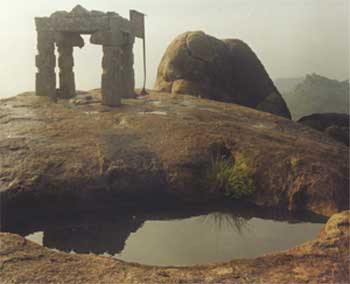 |
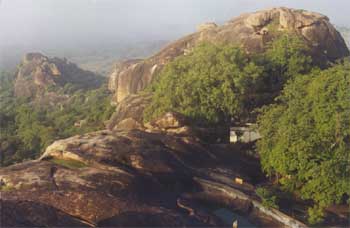 |
as seen from Tirumal Girīswara |
1) unai tinam tolutitan
Kanatil in payamara mayil mutukil varauaye (song 26) PTT.
Tiruppankiri Janiurai Saravana Perumalar.
2) Muntu Jamil malai koti koti.
Cempon Mayil Mītu yeppiclu Varauaye (page 15, song 30)
Centil nagar Valum Anmaikara Perumālē
3) Swanār manam kulirā
Aduyenai Arcalenai Varavenum (page 18 song 34)
jagamelmai kanda viral Perumālē.
4) Enta phikayinum
Canda capai tamil enatiram urykavam varuvaye (page 20
Kanta Pholil tikal kurumali maruaiya Perumālē.
5) Tarayit manutar Acinal -
Patiya tana camūti manolayam Vantu Tarai (page 23)
Vatinatamalai yavayum meviya Tampiranai (page 25 song 45)
6) Akarumai
Enatu munnoti varavēntum
Malai micai meviya Perumālē.
7) Kumpakōnam ulayenkum maveya perumālō (whole world) (pp. 27-28)
Swami discussed the importance of how he culled the Tiruvakuppu particularly expanded Vēlvakuppu to Vēl Maral and the importance of other vakuppus such as: (1) Kata Kaniyal Vakuppu, (2) Tēvedira Cankuvakuppu, (3) Vēl Vakuppu, (4) Sīrpāda Vakuppu, (5) Vēl Vangu Vakuppu (6) Vetici Kavalan Vakuppu.
Regarding the efficacy of the above vakuppus, Swami had sufficient experience to prove as in each of which certain aspects of Lord Murukan are sung about, such as His Holy Feet, Vēl, His Consort Valli, Peacock vāhana, etc. Further, the combination of words in every vakuppu is very mystical and divine. Saint Arunagirinathar alone could render such songs which Swami with the blessings of Lord Murukan and Sri Valli could popularise among the needy.
Vel Maral (Maikkaval)
The story goes as explained to me that one mantravādi who styled himself 'Triloka Murukan' played his powers on Swami at Vallimalai (in the year 1928) when Swami could not sing. Further by the grace of Lord Murukan he could remember Vēlvakuppu, which he rearranged by permutation in the 64 lines out of 16 lines of Vēlvakuppu and recited against the mantravādi. As a result the mantravādi's entire body got burning sensation and ultimately he surrendered to Swami with a promise that he would never use such powers in future .
The efficacy of Vēlmaral for the benefit of suffering humanity has been proved. This has become a ready spiritual guide for getting over all sorts of difficulties including psychic ailments. Even today there are many who enjoy the benefit in reciting Vel Maral.
Tēvenēndra Canku Vakuppu
Swami was very particular that this vakuppu has to be considered as the best approach to Devi Valli as Śodasaksari Mantra (16-syllabled mantra), described with Sanskrit words (Deva Bhāsā). One has to enjoy the result by reciting this vakuppu systematically.
Tiruppukal Parāyana Tayaneri Tirumurai
The songs in this name has been compiled by Swami with all possible guides to attain mental peace as well spiritual progress to attain moksha (1996 publication is available with S.T. Sabha).
Tiruppukal Jñāna Saccitānanta Valli Caritiram
This is entirely based on Jīva BrahmĀ Ikyam of Sri Valli (all jīvātmas with Lord Murukan-Paramātma). At every step we are expected to confess our shortcomings and reach the final step at the feet of Lord Murukan on 31st December every year and return back home relieved from our mental distress by the grace of Lord Tiruttanikēsan.
Vallimalai Swami had special attachment with Tanikēsan and His consorts. Swami attained samādhi on 22 November 1950 though Ajña Cakra (Tiruttani). Lord Murukan tested Valli in three ordeals, namely: (1) interest in family life; (2) interest in ornaments and other attractive materials like garments; (3) interest in other attractions in narration of purānam, palmistry, etc. None of the three interests had any impact in Her mind except that of Lord Murukan and ultimately Valli attained sanmargam (jīva-BrahmĀ ikyam).
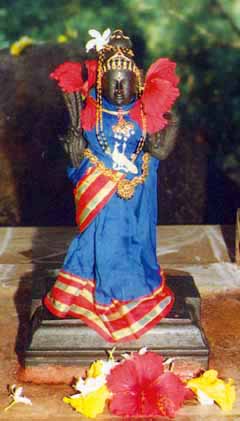 |
| Vallimalai Pongi Devi |
Valli Malai
At Vallimalai he inducted farmers, simple village youths, great scholars and well-known musicians all into his fold effortlessly as a way of stating that soul has no creed or cast. Special mention to be made in connection with a hunter girl of seven years, named as Valli by Swami, who had the most bewitching voice in rendering Tiruppukal songs. Similarly one blind destitute boy of eleven years could master all songs as educated by Swami, and named him an Kannappa Bhagavatar.
During Swami's lifetime I had the rare opportunity to receive and own and play his four-stringed instrument called jati vadyam, a very rare instrument invented by Swami and as a replacement of eratara which he had earlier (a single-stringed instrument). The four stringed one has a thrilling effect when Swami played during Tiruppukal recitals. On many occasions as he related to me, this instrument vanished from His hand at Vallimalai and Sri Valli Herself played with it for few minutes. As such this instrument has been nick-named by Swami as Pongi vadyam (played with help of two sticks one thin and another thick.)
Last but not least, an interesting incident happened at Vallimalai during Swami's stay. Early one day three people -- a renowned mendicant, a leading lawer, and an industrialist -- were curious to meet Swami in connection with a hearsay that Swami had the ability to convert iron into gold. As usual they were received at Vallimalai and given a warm reception over a cups of coffee, which they never expected to get at the top of Vallimalai.
As they started questioning Swami about their doubts, with a smile on his face Swami read out Tiruppukal songs narrated by Saint Arunagirinathar in his Cittu Vakuppu, detailing items to be procured and used properly as directed therein. If any of the items are unavailable, the attempt will be only a waste of money and time. Instead one can spare the time (in search of such items) in concentrating the feet of Lord Murukan who is ready to bless and give anything.
This upadesa had a marvellous effect upon the lives of those visitors who left Vallimalai fully charged with the grace of Valli-Murukan and Swami. One among them, Swami Anvānanda, was ordained by Valli to construct a temple for her at Chennai in the year 1954 as Sri Vaishnavi temple.
Just a few months before Swami attained samadhi he made his spiritual force enshrined in the image of Sri Vaishnavi Devi as named by him early on 12.1.1950 with kara sparsam and singing Tiruppukal (Tēvēntira Canku Vakuppu). Subsequently Devi had Her domain very prominently at Tirumullaivayal near Chennai, attracting very many devotees from for and wide. Devi fulfils the love and affections that Swami was pouring on the devotees even after His lifetime.
A few months before He left the world, perhaps had a duty to attend the samadhi of Sri Ramana Bhagawan about which Swami could visualise on 4 April 1950, ten days before the event. On 14.4.1950 Sri Ramana Bhagwan left the world as known to Swami and confirmed that Sri Ramana is still among us as a bright star among other stars in the sky to bless us.
In October 1950, I visited Vallimali for the first time and returned after a short stay. The significance of this trip occurred to me later. While in Madras, Swami had arranged for a six day Skanda Sasti festival during 10th November 1950 at Thambu Chetty Street, which I participated in.
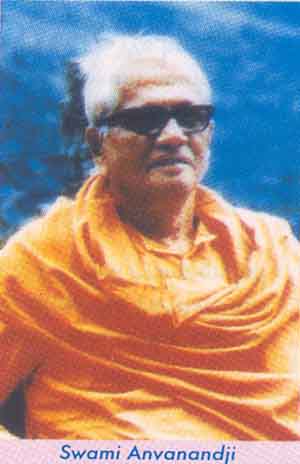 |
| |
| |
With the help of Sri Swami Anvananda, in whom Swami had full faith as his torchbearer, I took the body to Vallimalai and interned it in the cave which he had previously prepared for his samadhi. My visit to Ramanasramam after Mahārshi's samadhi helped me to make similar arrangements at Vallimalai. Sri Mauna Guruswami had kept the whole place neat and clean, in a fitting manner for the internment of the body. He continued to live in the asram and maintained the samadhi from that date onwards for seventeen years.
In conclusion, all my eloquence fails to express the greatness of Vallimalai Swami and the experiences I had with him for the short period of two years. For the trivial services I rendered to him, I find he continues to shower his grace on me since that time.
Pazhayanur Subramania Krishnan Iyer, b. 1912, is President and Founder of the Sri Vallimalai Swami Satchidananda Tiruppugazh Sabha and Trustee of Sri Vaishnavi Shrine, Tirumullaivayil. He was personally associated with such saints as Ramana Maharshi and Sri Vallimalai Swami Satchidananda.
For more inforation, visit the Valli Malai home page or contact the author:
| Author P.S. Krishna Iyer offers aarati to Vaishnavi Devi utsavar during annual Tiruppukal celebration, April 2000. |
Pamban Swamigal
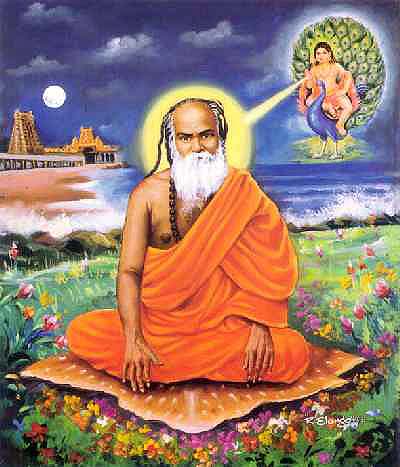 |
 |
| (1848-1929) |
Pamban Swamigal
His Life Example & Teachings
by VN Soundararajan
Appavu Research Foundation, Chennai
In the year 1848 a child was born to a Saivite family in Rameswaram district village called Pamban. The child was named Appāvu but later became known as Pamban Swami as he had lived and left his family at Pamban Island. A psychic predicted that Appāvu would be great man of words and wisdom. In his school days, Appāvu was very good in his studies and other activities and ranked high in Tamil and English.
Pāmban Srimat Kumāragurudāsa Swāmigal
(1848-1929)
At the age of thirteen, on a Friday at
sunrise Appāvu had a vision and was induced to write poems on Lord Kumāraguru, which he wrote immediately on a palm leaf in a facile pen in his coconut estate. He wrote one poem each day before his lunch for 100 days, ending each decad with his manasika guru's name Arunagiri Nāthar. After seeing Appāvu's poem, a temple priest named Seddu Madhava Iyer marveled at the young boy's knowledge of Tamil and his faith in Lord Murugan. Later Appāvu was given upadesam on the holy six-letter mantra on Vijaya Dasami day at Agni Tīrtham by the Rameswaram seashore temple and was made to read Sanskrit by Seddu Madhava Iyer.
Since Pāmban Swāmi was interested in the holy life from the early days, his parents and guru Seddu Madhava Iyer were keen to get him married soon in the year 1878. His wife's name was Kalimuthami; they had one son and two daughters. Even after marriage Pamban Swami lived like a saint, mostly doing pujas and prayers.
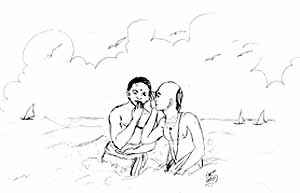 |
| |
![Pamban Swami and wife pray for their sick daughter [11k]](http://murugan.org/pix/pamban_daughter.jpg) |
| |
One night Pāmban Swāmi's daughter was crying due to illness. Her mother requested Pamban Swami to give vibhuti to the crying child but Pāmban Swāmi refused to do so and informed his wife to pray to Lord Murugan for help and started his meditation to Lord Murugan. She did as she was told by Pāmban Swāmi. After sometime Pamban Swami saw the child was not crying and found her fast asleep. When Pāmban Swāmi asked the mother about the change she replied that after her prayer to Lord Murugan, a saintly figure came inside the house and applied vibhuti on the child and went away. From that moment on the child was cured. He felt that Lord Murugan himself came and helped him at their request.
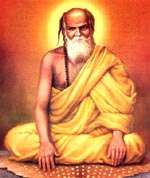 |
One day a friend of Pamban Swami informed him that he was going to Palani, the sacred hill temple. Pamban Swami also wanted to got to Palani and left his family life without informing them. When his friend asked if he had permission from his god, Pamban Swami said 'Yes' and lied to his friend. On the same day Lord Palani Murugan appeared before him with a smiling face and said " If I want your presence at the hill I could have done it easily. There is no reason for you to lie. I will call you when the time comes. You may remain there without any attachments." Then He asked Pamban Swami to promise that he would not go to Palani without His permission.
To keep his word Pamban Swami never went to Palani till his last days. Pamban Swami also gave up the taste of lime, salt, and hot spices. He used to take plain rice with green dal and ghee. He used to take food only once a day before noon; if he missed the time he would take food the next day only.
In 1891 Pamban Swami wrote Shanmuga Kavacam, a powerful hymn of 30 verses composed for the benefit of Lord Murugan's devotees to protect them from illness of body and mind as well as from foes, wild beasts, poisonous creatures, demons, devils and biting insects. Several instances prove that this Shanmuga Kavacam verses effective in this respect. If you recite it with heart and soul to Lord Murugan, the results will be swift and miraculous.
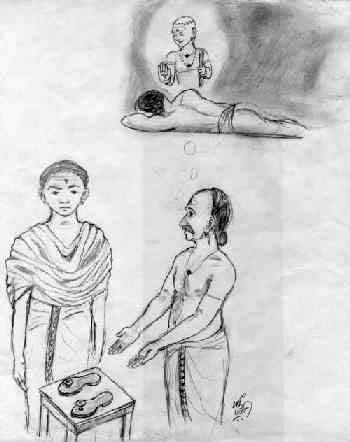 |
| |
Also in 1891 Pamban Swami composed Pancamrita Varnam. Lord Murugan Himself has said to an old lady in Tiruchendur that "I will be present physically wherever the song is sung on a pleasant note." If anyone does puja inside the heart by reciting this poem, it is equal to doing abhisekam and puja.
One time Pamban Swami was walking on a rough track and a thorn pricked and pierced into his foot. The terrible pain made Pamban Swami to shed tears and pray to God. On the same night Lord Murugan came in the dream of a cobbler in the next village and informed him to make and give a pair of slippers to Pamban Swami. When Pamban Swami was traveling to the village the next day the shoemaker came with the pair of slippers to Pamban Swami saying that in his dreams Lord Murugan came and had given instructions to make a pair of slippers for him. Pamban Swami was very much pleased and thanked Lord Murugan for his kindness to His devotees.
Pamban Swami was once very ill due to diarrhea. Due to this he fainted and fell down and upon seeing this his wife fainted too. Lord Murugan came to their house just then and tapped with a stick, made Pamban Swami's wife get up and said "Don't worry. He will be alright. Just smear vibhuti on his body and say 'I will never leave you'." But Pamban Swami's wife was afraid to touch vibhuti as it was her menstrual time. Lord Bala Murugan said to her, "There is no prohibition during emergency." She did as she was told. Immediately Pamban Swami was cured.
One day someone told Pamban Swami that a poet was writing a song of 100 verses that was incomplete for the last two months. Upon hearing this Pamban Swami decided that he would compose a song similar to that. So he started and finished 125 verses within an hour. To this day no poet or saint has duplicated such a feat. The poem is called Tiruvorumalai Komagan. The first verse of four lines consists of 64 words to each line with total 256 words. Pamban Swami composed the remaining 124 verses without adding any other words. He said with the divine guidance anything is possible. 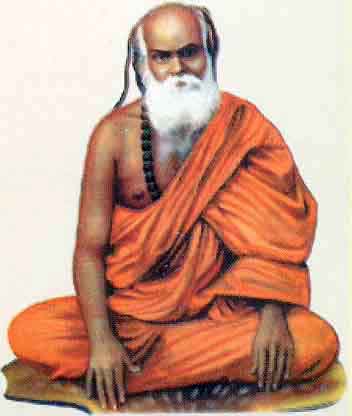
On his visit to Kanchipuram in Tamil Nadu, Pamban Swami had failed to visit Kumarakottam, the famous Murugan temple in the town. On his way back Lord Murugan appeared before him in the form of a 30-year old man with a turban and asked if he had visited Kumarakottam where Kanda Puranam was composed by the temple priest Kanchiappa Sivachariyar. He took Pamban Swami near to the temple and vanished. After the pujas, Pamban Swami was very much delighted by the grace of Lord Kumaran. In the railway station the train was delayed due to some fault as though it was only waiting for Swami and then the train proceeded without delay.
In the year 1894 at Peerapan Valasai near Ramanad in Tamil Nadu, Pamban Swami was determined to get upadesam from Lord Kumara Palani Andi himself and from no one else. So he obtained permission from the government officer to dig a pit in the burial ground to the size of 3' x 3' x 3' covered with lock & key for the roof. Before starting meditation he asked his followers to have faith in God. Because this was a burial ground there were a lot of disturbing events that took place. Once a big demon tried to seize Pamban Swami, but by hurling his dandam the demon vanished. On the seventh night a voice commanded Pamban Swami to get up. Pamban Swami replied that unless Lord Palani Andi Himself comes he would not get up, even if he had to die. Once again the voice said, "Your Lord has come to see you. Open your eyes."
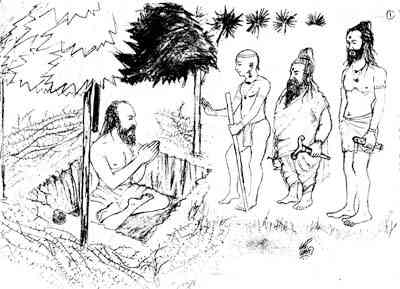 |
| |
Pamban Swami was delighted to see Lord Murugan in the form of Palani Andi with a dandam in one hand and the other hand in chin mudra accompanied by two rishis. With a smiling countenance Palani Andi came forward and gave a "single utterance" (oru mozhi) upadesam in Pamban Swami's right ear. After that they turned back, walked towards the west and vanished. Without getting up on hearing that one word Pamban Swami was very much pleased and continued his meditation for 28 days without food, water or sleep.
On the 35th day once again a voice was heard and commanded him to "Come out of the pit." Once again Pamban Swami replied that only if it is by his Lord he would get out. The voice said "Yes it's me." At once Pamban Swami got out of the pit and saw Citra Poornima full moon in the sky. He had a cloth of one piece cloth like Patanatar or an āndi.
Later his followers requested him to wear two pieces of white cloth one around the waist and the other over his shoulder. Pamban Swami was content to remain in silence but others wanted him to speak of his experience. Even today the oil lamp that Pamban Swami used in the pit is preserved in Ramanad town by Pamban Swami's followers.
In 1895 Pamban Swami took sannyasa and left Pamban village. One day Lord Murugan appeared in his dream and asked him to proceed to Madras.
 |
| |
On his arrival at Egmore railway station in Madras a cartman came to Pamban Swami and requested Pamban Swami to sit in his cart. Without saying anything Pamban Swami sat in the jatka. The cartman took Pamban Swami to St. George Town to house number 41 Vaithiyanath Mudali Street. Pamban Swami got down from the jatka and in front of him an old lady Mrs. Bangaru Ammal came to Pamban Swami and told him that in a dream the previous night Lord Murugan had said that a saint would come to her house and that she should provide him with food and accommodation. And Pamban Swami accepted her invitation and stayed there for some time.
In the year 1896 Pamban Swami went to Chidambaram and wrote an upanishad known as Thagaralaya Rahasiyam. Lord Guha lives in every heart in a tiny light form. Pamban Swami gives examples from the Vedas, agamas, upanishads, Tevaram, Tiruppukazh and other scriptural sources. Pamban Swami also wrote two books known as Tiropa and Paripuranat Būthan. In this book, Pamban Swami provides quotations from all the 108 upanishads. Pamban Swami is the only saint who has composed 50 poems on Lord Murugan in pure Tamil without any words from other language due to his love on Tamil. Pamban Swami once said that any one who speaks ill of Sanskrit or Tamil is his enemy. The two sacred language are like two eyes. You cannot have one and leave despise the other if you want full knowledge of the spiritual world.
On Pamban Swami's visit to Varanasi, he stayed at Kumāra Guruparar Mutt. Pamban Swami wrote that he was very happy to stay at this famous mutt. The head of the mutt once offered kavi cloth by taking away his white dress and requested Pamban Swami to wear it. Pamban Swami at first hesitated but upon reflection Pamban Swami took it as God's wish from that day to wear two-piece kavi dress.
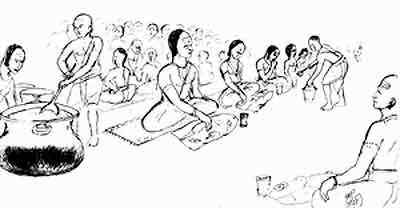 |
| |
Once on a Shasti Pūja when Pamban Swami was present, the devotees had cooked rice for one hundred. But the one rice pot kept giving rice enough to feed nearly 400 people. So much was the demand that the other foods like vegetables, sambar and rasam had to be prepared three times, but the cooked rice never got emptied. Such miracles were commonplace in the life of Pamban Swami.
While in Madras, Pamban Swami had a premonition of his mother's death and his elder son's death. Before the telegram came Pamban Swami gave instruction for no one to disturb him because he is a sannyāsi, a man without family or bindings.
Once at Pinathor near Chidambaram the Vainavas wanted to kill Pamban Swami and tried via black magic. When a demon approached him, Pamban Swami said to him "I have not done any wrong. Return to the person who has done the wrong". Next day he heard that one Vinita was dead suddenly. Swamiji also filled cases for more than seven years against persons who had published ill of Siva and Saivites He won every case with the help of Lord Murugan. Research papers on these Vainavas entitled Nalāyiraa Prabandha Vicāram and Siva Samaya Sarabam were published by Pamban Swami; the Vaisnavas purchased all five hundred copies and burned them due to ill feelings.
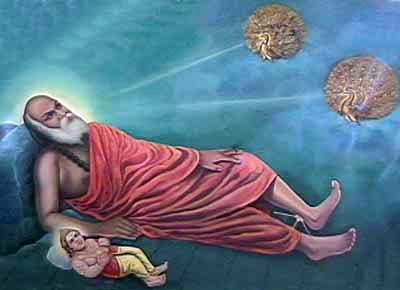 |
| |
In December 1923 Pamban Swami had an accident at Thumbu Chetty Street in Madras. Pamban Swami was run over by a jatka and his left ankle was broken. He was admitted to the General Hospital. The doctors who attended upon Pamban Swami's leg said it would have to be amputated.
Pamban Swami was only praying and said "Let them do what they want do." On hearing the news only Chinaswami Jothidar had abnormal faith in Pamban Swami's poem Shanmuga Kavacam and started to recite it. Chinnaswamy Jothidar had a vision of the Vel entering Pamban Swami's broken ankle. Miraculously the leg was cured in the hospital. Even British doctors were astonished and described it as divine grace.
On the 11th day Pamban Swami saw two peacocks dance before him and also saw Lord Murugan in a infant form lying next to his bed. In remembering the day Pamban Swami told his followers of the Maha Tejo Mandal Sabhai to believe in Lord Murugan and to do Mayūravahana Sevana Vizhā without fail. Pamban Swami's life proves this. "Vēlum Mayilum Thunai" is a not just a saying; it really helps sincere devotees in need.
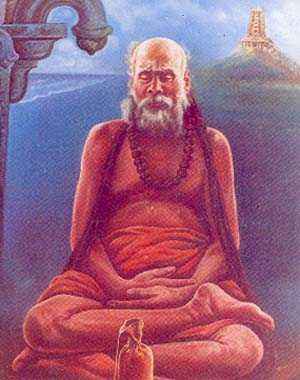 |
| Pamban Swami breathes his last at Tiruvanmiyur seashore, but his thoughts are on Palani Murugan (above right). Below: original photo of Pamban Swamigal at the time of his samādhi |
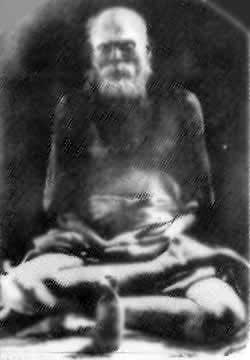 |
Kumaraguru Paraswamigal
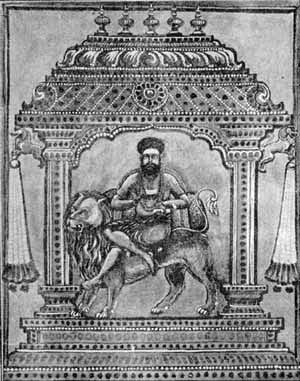
Another classic of the 17th century in praise of the of Tiruchendur is Kandar Kalivenba by Kumaraguru Paraswamigal, a Saiva ascetic. The author was horn in 1625 A.D. of a Saiva Vellala family at Srivaikuntam on the northern hank of the Tambaraparani, nineteen miles from Tiruchendur. His parents Shanmukha Sikhamani Kavirayar and Sivakami Ammaiyar were blessed with this child after a long penance to Muruga of Tiruchendur. The boy grew of age and until his fifth year showed no signs of speech. The parents were pained at this and resorted to Tiruchendur penance again. Weary of waiting for months and seeing signs of approaching speech, the parents determined to drown themselves in the sea along with the child if he would not speak by a particular day.
The day dawned, and yet there were no signs. At last, both the parents and the child entered the foamy waves. Deeper and deeper they went from knee to neck and, as they were about to sink with the waves over their heads a human form appeared with a flower in his hand and asked the child what it was; when lo! the child broke out in praise of the Lord with the words of the lines.
Pâmêvu teyvap pazhamaRaiyum…."
This poem, the Kantarakalivempâ of 244 lines is a delightful piece of the Lord's praise and the truths of Saiva Siddhanta. And it is considered even now with great propriety that its recitation with warmth and fervour wards off many an evil attending on man.
Having studied Tamil at the feet of his father Sanmukacikâmani Kavirayar, and attained in it great proficiency by divine grace, he grew up to manhood, took to an austere way of life, left home, and wandered throughout the Tamil country visiting famous places of pilgrimage and composing poems on the presiding deities. When he was at Dharmapuram, he was drawn to the monastery's head Mâcilâmani Tecikar, and begged him to be admitted as his disciple and initiated into the sannyâsa âsrama. Mâcilâmani asked the young poet to visit important pilgrim centers including Benares, and return to him then. Kumarakuruparar felt incapable of such undertaking, arduous and dangerous in those days. He was directed to stay at least in Chidambaram for some time and then apply. He complied with this condition and afterwards took the holy orders. While he was a court-poet of Tirumalai Nâyaka at Madurai, one day as he was inaugurating his devotional poem in praise of goddess Mînâtci at the royal court, the goddess appeared herself as a young maiden and sat on the lap of the Nâyaka king, and taking a necklace of pearls, put it on the neck of the poet and vanished.
Finally, Kumarakuruparar left for Benares. His fame reached even the Mughal court at Delhi. Emperor Aurangzib expressed a desire to see him, and the poet-saint (who had in the meantime mastered Urdu) rode to the Mughal court on the back of a lion, the symbol of courage and pride. The emperor was so much impressed by the poet's holiness and learning that he bestowed on him a plot of land in Benares near the Kedar Ghat, and there Kumarakuruparar built the Kumârasvâmi monastery which became soon the heart of religious activities. He lived in Benares till the end of his days except for a short visit to the South to pay his respects to his guru. The tradition also says that Kumarakuruparar who was very fond of Kampau's Tamil Râmâyana lectured on it in Benares and that Tulsîdâs, the great Hindi poet of Râmcaritmânas, heard these talks and became indebted to Kanpan through the lectures of Kumarakuruparar.
Saint Arunagirinathar
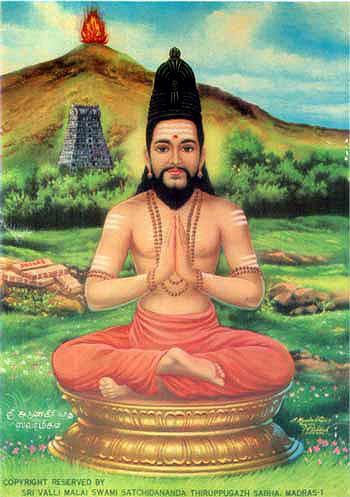

Arunagiri worships Lord Murugan who had just rescued him from certain death by suicide. Painting from Tiru Avinankudi Tirukkovil, Palani.Arunagirinathar
Arunagirinatha was a traditional type of devout Hindu. Lord Muruga was the family God whom his ancestors have been worshipping. In his Tiruppugazh, he prays: “Oh, Kanda! The glorious God of the hills! Pray bestow Thine blessings accepting the ardent worship of this humble son to You, my ancestral deity."[1]
His learning, especially of religious and spiritual literature must have been acquired in his early years and it was both vast and deep. In the Tamil language, he excelled in expression and learning. In his compositions, he exhibits familiarity with the Tamil Works such as: Tevaram, Tirukkural, Kaarigai, Ula, Easal, Kalambakam, Kovai, Sindu, Madal and Maalai. He had also cultivated the art of writing eulogies of rich men to obtain presents of money from them.[2] His compositions abound in the use of Sanskrit words and they also show that he was familiar with the Itihasas, Puranas, the Gita, the Upanishads, Agamas, Mantra and Tantra Sastras, Yoga Sutras and Kama Sutra.
His archanaon Lord Muruga in two songs are mostly in Sanskrit.[3] One is therefore entitled to assume that his mastery of Sanskrit language was equal to that of Tamil and that he was quite capable of composing original work in Sanskrit. Unless he was born in a family whose traditions were such that every young male member from his early years received the highest cultural and religious education, prevailing in those days, it would not have been possible for Arunagirinatha to have acquired the vast learning that he has exhibited.
That he was leading a debaucherous life in his early years is admitted by him in his prayer to Lord Muruga, thus: “Will I ever get to know how to attain Your holy feet before becoming too old wasting my youth, as I am, by indulgence in sinful sexual pleasures?”[4] Here one must utter a word of warning that all references to a life of lust in many of his poems should not be taken literally -- that is to say, as confessions of his own guilt.[5]
But his life of debauchery could not have lasted very long. Perhaps, it proved to be a costly indulgence and he was soon reduced to a life of penury and became very dejected. In one of his songs, he says:[6]
"…To me, who seeks the company of prostitutes all the time, spending on them whatever little money I earn by bestowing lavish praises on men who lack wisdom, who never pray to Your holy feet, who are dunces, who indulge in devilish activities and who have no sense of gratitude; pray Muruga, grant me Moksha (from all this)".
In another song, he speaks with poignant emotion about his despicable state, thus: [7]
"…Ridiculed and jeered at by my wife, by the people of the town, by the women of the place, my father and my relations being disgusted in their minds by my conduct, everyone scolding me or indulging in loose talks about me and being treated as a despicable person by the very people whom I have loved, my mind became confused and full of gloom. I thought within myself, ‘Is it for this that I strove to obtain this human body which is a treasure, indeed?’…"
| i. |
The first sign of God's grace and compassion came to Arunagirinatha after a Mahatma sought him and spoke to him in a sweet voice with love and affection. The Mahatma advised him "to meditate on the six-faced God Shanmukha".[8] But Arunagirinatha did not heed the advice for some time and people began to deride him for ignoring the advice of the Mahatma. A change soon came over him. He began to worry very much over his pitiable state. He thought of the advice of the Mahatma and attempted to spend some hours in meditation facing the image of Lord Muruga installed in the Gopuram. But his will, weakened by his immoral life, lacked the strength to persist in that attempt. The crisis in his life started mounting up. He decided to surrender, at the feet of Lord Muruga, the body that had failed to serve Him in any way, He decided upon suicide. At this moment, Lord Muruga appeared standing on a dancing peacock, halted him in the act and took possession of him.[9]
"Oh Gurunatha! You came along on the peacock holding the Vel that broke to pieces the Krauncha Mountain in Your hand and took possession of me in that the people of the world may admire Your grace."
"When I was about to shed life from my body, out of compassion for me and to elevate me to a better and praise-worthy status, You came upon the scene, dancing, accompanied by Your celestial devotees and showered grace on me.”
One must assume that after this surrender to Lord Muruga that was accepted by Him, the lure of lust should have left Arunagirinatha. For, if surrender to the Lord does not relieve one instantaneously of all dross, then surrender will have no meaning. One may safely assert that after Arunagirinatha was taken possession of by the Lord, all prayers in his songs thereafter seeking to be relieved from the attraction of lust are for the benefit of others and not for himself.
Here, one must pause for a moment. Was Arunagirinatha’s decision to end his life born of mere disgust and frustration, a simple attempt at suicide, in order to put an end to suffering, which can no longer be endured? One must remember that God does not intervene in every instance of attempted suicide to save the person. The manifestation of Lord Muruga standing on his dancing peacock is not an every day occurrence. It is not vouchsafed even to His most sincere devotees. Yet Arunagirinatha the dissolute was rewarded with this supreme act of compassion.
In our sastras, it is said that the state of mind of a person at the last moment when life is about to leave the body, is very important from the point of view of his rebirth. If one were to utter the name of Narayana or Shiva and fix his mind on His form at the time of death, he is assured of moksha and release from rebirth. Arunagirinatha had realised with great poignancy that the body had failed to serve the purpose for which God had intended it. He had misused it for immoral purposes. What was there left for him to do except to surrender the mind and the body to the Lord? He sings thus:[10]
Oh mind of mine!
Trust not the body
That infernal machine
Turning out pleasure and pain.
Brahma who sits on the Lotus
Created it to bind the mind.
Oh mind of mine!
Free thyself from fear.
To seek Him, endeavour
Patiently and steadily.
Let us go to Him
Show our love and surrender.
Oh mind of mine!
It's good you decided to surrender.
See Him on His peacock Vahana
He has now taken charge of you.
Doubt not, there is no Greater State.
Dwell on His holy name
Always, ‘Mainda, Kumara'.
A kshatriya warrior of old, leaving his house, his wife and children and relatives and abandoning all his desires and possessions, goes to the battlefield with the assurance that if he should die there, he will attain Vira Svarga (Valhalla). Similarly, a great bhakta is always prepared to sacrifice a limb or an eye or even his life for the sake of God in the full belief that the Lord will accept the sacrifice and make him one of his possessions. Lord Muruga came to the rescue of His devotee who was preparing to shed his body and saved him not only from death, but accepted him as dear to Him and took possession of him. How beautifully Arunagirinatha has expressed it when Lord Muruga appeared before him!
Kinkini thith thimi, thith thith
The anklets on the dancing feet jingled,
A sound that to other sounds
Closed my hearing.
The Kadamba garland that He wore
Suffused me with its cloying fragrance,
And my breath was held.
His moon-like countenance and tender smile
Caused such cheer and ecstasy
That my mind was lost.
For a moment He looked at me,
A cool liquid light poured out
From His long lotus eyes.
It filled my heart tasting like nectar
And I was lost to Him forever.
Bhogar Siddhar
The life of Bhogar Siddhar
Bhogar was a South Indian by birth, belonging to the caste of goldsmiths, who became a siddhapurusha under the guidance ofKalanginaathar. In Bhogar's Saptakanda he reveals details ofvarious medicinal preparations to his disciple Pullippani (so named ashe is believed to have wandered in the forests atop a puli or tiger)and at every stage he quotes his guru as the authority. Also Pulippani must have been a young man then, as he is often referred to as abalaka.
It is said that as per the last wishes of his guru, Bhogarproceeded to China to spread the knowledge of siddha sciencesand strangely enough his journey is said to have been made with theaid of an aircraft; he demonstrated to the Chinese the details of theconstruction of the aircraft and later built for them a sea-goingcraft using a steam engine. The details of these and other experi-ments demonstrated by Bhogar in China are clearly documented in theSaptakanda.
Bogar's guru, Kālāngi Nāthar, is believed to be a Chinese whoattained siddhi in South India and thus became included among theEighteen Siddhars.
Lao Tse - the founder of Taoism (5th century B.C.) was the firstChinese to propound the theory of duality of matter -- the male Yang andfemale Yin -- which conforms to the Siddha concept of Shiva -Shakti or positive-negative forces. This very same concept wasfirst revealed by the adi-siddhar Agasthya Rishi, whose period isas old as the Vedas, which have been conservatively dated at3500 B.C. Also alchemy as a science was practised in China onlyafter B.C. 135 and was practiced as an art until B.C. 175 when a royaldecree was enacted banning alchemical preparation of preciousmetals by the Celestial Empire; these details are recounted in the twoexisting Chinese books of alchemy Shih Chi and Treatise ofElixir Refined in Nine Couldrons, both dated to the first century B.C.
The emergence of Lao Tse with his theory of duality of matter and thejourney of Bhogar to China seem to have taken place about the sametime and it is even possible that Bhogar himself went under the name ofLao Tse in China, like another Siddharishi Sriramadevar, who wasknown as Yacob in Arabia.
This seems likely considering that:
- before Lao Tse the conceptof duality of matter finds no mention in any Chinese treatise;
- alchemy as a science emerged only after B.C. 135, i.e. four centuriesafter Lao Tse;
- there was a sudden spurt of alchemical practiceaher the emergency of Lao Tse; and
- the duality of matter andalchemy have been mentioned in South Indian scriptures thatantidate Lao Tse by centuries.
The shrine at the top of the hill, though later than theTiru Avinankudi temple, has overshadowed the older temple in thepresent century due to its popular appeal. Created by Bhogar, it wasmaintained after him by sage Pulippani and his descendants almostas their personal and private temple.
During the time of Tirumalai Nayak, his general Ramappayyanhanded over the puja rights to newly brought Brahmin priests. Thedescendants of Pulippani were compensated for the loss of this rightby being given:
- Certain duties of superintendence
- Right to some annual presents
- Right to shoot off, at the Dasara Festival, the arrow whichsymbolises Subramanya's victory over asuras.
- Right to be buried at the foot of the steps leading to thehill, if some of them so chose.
Maha Yogi Sri Agastiyar: The Ageless Guru of Gurus
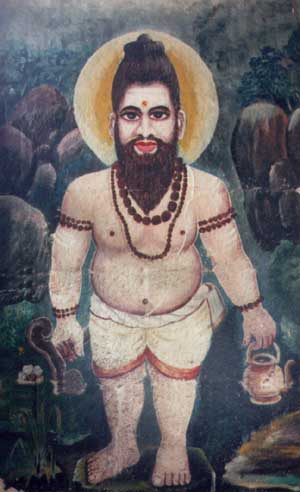 |
Maha Yogi Sri Agastiyar Agastyar Kovil, Agastyar Falls, Papanasam (http://muruganadimai.blogspot.com) |
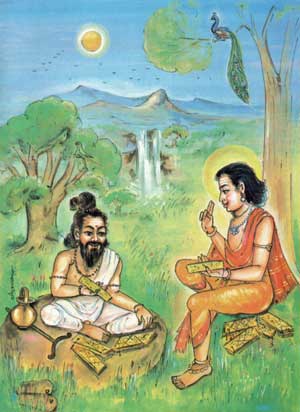 |
Sri Murugan teaches the Tamil language to Agastiyar (http://muruganadimai.blogspot.com) |
A rare and illuminating book in English on the life and works of the great siddhas of ancient and modern times, with particular reference to Sri Agastiyar, the archetype of all siddhas and gurus, was published in Canada recently, entitled Babaji and the 18 Siddha Kriya Yoga tradition, written by Marshall Govindan, an advanced Kriya Yoga sadhaka of Los Angeles and a keen scholar, who had carried out extensive literary and spiritual research in India and Sri Lanka for twenty years under the guidance of Yogi S.A.A. Ramaiah.
In the hierarchy of siddhas or perfected human beings, or Initiates of the White Brotherhood as they are called in the West, who have guided the destinies of nations on our planet Earth for the past 12,000 years of recorded history, the ageless legendary siddha Sri Agastiya Maha Muni stands out as the senior-most guru who initiated a galaxy of eminent gurus and siddhas down the ages, and who had established and nurtured the ancient Dravidian civilization lasting several millennia. He is also acknowledged, in occult circles, as the head of a representative group of rishis entrusted with the guiding of the destiny of India and other nations called the Sapta Rishis as disclosed in certain ola leaf manuscripts called rishi vakyams and also in theosophical writings. Sri Agastiyar is also considered the author of several Rig Vedic hymns in Sanskrit connected with the Aryan civilization of the North.
Sri Agastiyar’s role in the Ramayana
In the Ramayana saga, which is deemed by historians to have taken place about 9,000 years ago in the Treta Yuga, Sri Agastiyar is reported to have appeared before Rama himself on the day before the final victorious termination of the war with Ravana, the hitherto invincible King of Lanka, and initiated Lord Rama with a special divine mantra to counter the effect of the powerful boons that Ravana had earned from the gods by his great tapas.
It is significant to note that, according to geo physical research based on the movement of the continental plates, the Lanka of Ravana was situated in the continent of Lemuria, also known as Kumari Kandam, which was a land mass, connecting the Deccan plateau in South India and the island of Ceylon, with intervening straits to be crossed, with Madagascar in the West, Australia on the East and Antarctica on the South, until it sank into the Indian ocean in stages over 3,500 years ago, as mentioned in the writings of the German geologist Wagner anti the eminent Indologist Sir T.W. Holderness.
The research done by Fr. Heras and Sir John Marshall the archaeologist and other scholars into the archaeological finds at Mohenjodaro and Harappa point to the existence of an earlier highly developed Dravidian civilization in the deep South which, had influenced the Indus-Valley Aryan civilization of the North.
The available historical evidence referring to the Dravidian civilization commences with the records that have come down to us of the Tamil literary writings during the past 12,000 years, which have been divided by historians into three periods, called the First Sangam period from 9600 BC to 5200 BC, spanning the Satya and Treta yugas, the Second Sangam period from 5200 BC to 1500 BC spanning the Treta and Dwapara yugas, and the Third Sangam period from 1500 BC to 600 AD spanning the Dwapara and Kali yugas.
According to the present cycle of four yugas, namely Satya, Treta, Dwapara and Kali yugas, in their descending arc of 12,000 years and ascending arc of another 12,000 years, as stated by Sri Yukteswar in his famous treatis called ‘Holy Science’, we are now in the ascending arc of Dwapara yuga completed the Kali yuga period lasting from 600 BC to 1800 AD.
The Mahabharata war, where Lord Krishna propagated the teachings of the Bhagavad Gita to Arjuna, is reckoned to have taken place during the Second Sangam period about the year 3100 BC.
The First Sangam, which was founded and nurtured by Siddha Sri Agastiyar, lasted for 4,400 years and had its centre in the city of Dakshina Madura in the continent of Lemuria.
The Second Sangam, which was also established under the patronage of Sri Agastiyar, lasted for 3,700 years and had its centre in the city of Kavatapuram in the continent of Lemuria, after the records in the city of Dakshina Madura had gone under water.
The Third Sangam, also sponsored by Sri Agastiyar, lasted for 1,800 years and had its centre at Uttara Madura, namely the modern city of Madurai, which lays north of the earlier centres, after the whole of the Lemurian continent had gone under water.
After the commencement of the gradual inundation of the Lemurian continent, it is reported that Sri Agastiyar led a migration of Dravidians to Java and Cambodia and Central and South America. The legends of the Incas, Mayans and Aztecs of South America regarding the founding of their cultures by tall beared white-robed teachers confirm the tradititional view that the Lemurians, under the guidance of their siddhas, colonized North and South America, as well as the Nile Valley, when they founded the Egyptian civilization.
It is significant to note that Edgar Cayce the well-known ‘sleeping prophet’ of America, had in the course of his recent voluminous psychic messages given out by him while in a state of trance mentioned a similar sinking of the continent of Atlantis in stages into the Atlantic Ocean over a period of several centuries between 12,000 BC and 10,000 BC, before the sinking of the Lemurian continent.
Sri Agastlyar the Archetype of all Gurus
Maha Avatar Kriya Babaji of the Himalayas, the lineal Guru of Paramahamsa Yogananda, Yukteswar and Lahiri Mahasaya, who is well nigh 1,800 years old today, still retains a young physical body of a 16 year old youth, as a result of his divinising the cells of his physical body, after receiving initiation from two of the greatest siddhas of all time.
Siddha Boganathar instructed him in the higher Kriya yoga techniques, for six months at Kataragama in Sri Lanka in the year 214 AD and sent him thereafter to his own Guru Siddha Agastiyar at Couttalam in India, where Babaji had the final initiation in Kriya yoga, after he had practised severe austerities for 48 days to invoke the grace of Agastiyar, who finally appeared before him in his physical body emerging from the adjoining forest; and showered his full blessings on him.
These facts were disclosed by Babaji himself in 1952 to two of his disciples V. T. Neelakantan, a Theosophist of the early days, and Yogi S.A.A. Ramaiah, when he materialized in physical form from his abode in the Himalayas in the shrine room of V.T. Neelakantan at Suramma1 Lane, in Egmore, Madras. In.turn Babaji is known to have initiated among others the famous Hindu reformer Adi Sankaracharya into the mysteries of Kriya yoga about the year 800 AD.
Among the several Siddhas initiated directly by Sri Agastiyar were, according to certain sources, (1) Tirumoolar, the author of Tirumanthiram described as one of the greatest texts of yoga and mystic truth ever written, who lived for over 3,000 years in the pre-Christian era, and (2) Tiruvalluvar the author of the world famed classic scripture the Tirukkural, who lived 2,000 years ago.
It was the immortal Sri Agastiyar who originally taught and transmitted to several of his disciples over the ages the Kriya yoga techniques of divinising the cells of the body and:
- rendering the physical body deathless for centuries, (as in the case of the 18 Siddhas and Kriya Babaji), or
- enabling the physical body to disappear completely and resurrect in a glow of light into a subtler vibrational field, (as in the case of Adi Sankaracharya and the four great Saiva saints namely the Nayanmars and Kabir of medieval times and Ramalinga Swamigal as recently as 1874), or
- enabling the physical body to be placed in a tomb in jeeva samadhi at will, in a state of suspended animation, where the blood circulation and the breathing have stopped but a luminous pranic energy keeps the body-cells alive, with the possibility of the siddha dematerializing the body in the tomb and materializing it outside in a completely different locality and living out an extended span of life for several years (as in the case of three well-known siddhas of modern times, namely Sri Raghavendra Swami about whom a popular film had been made recently, Sri Kulandaj Ananda Swami whose last jeeva samadhi is in Madurai city and Sri Muthukrishna Swami whose jeeva samadhi is in Vallioor).





















